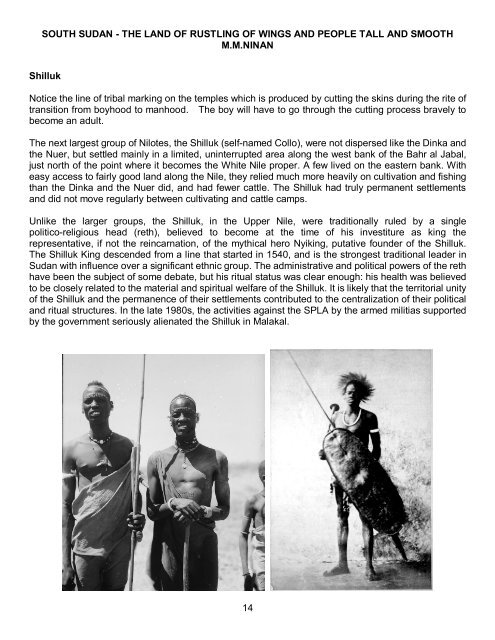Create successful ePaper yourself
Turn your PDF publications into a flip-book with our unique Google optimized e-Paper software.
SOUTH SUDAN - THE LAND OF RUSTLING OF WINGS AND PEOPLE TALL AND SMOOTH<br />
M.M.NINAN<br />
Shilluk<br />
Notice the line of tribal marking on the temples which is produced by cutting the skins during the rite of<br />
transition from boyhood to manhood. The boy will have to go through the cutting process bravely to<br />
become an adult.<br />
The next largest group of Nilotes, the Shilluk (self-named Collo), were not dispersed like the Dinka and<br />
the Nuer, but settled mainly in a limited, uninterrupted area along the west bank of the Bahr al Jabal,<br />
just north of the point where it becomes the White Nile proper. A few lived on the eastern bank. With<br />
easy access to fairly good land along the Nile, they relied much more heavily on cultivation and fishing<br />
than the Dinka and the Nuer did, and had fewer cattle. The Shilluk had truly permanent settlements<br />
and did not move regularly between cultivating and cattle camps.<br />
Unlike the larger groups, the Shilluk, in the Upper Nile, were traditionally ruled by a single<br />
politico-religious head (reth), believed to become at the time of his investiture as king the<br />
representative, if not the reincarnation, of the mythical hero Nyiking, putative founder of the Shilluk.<br />
The Shilluk King descended from a line that started in 1540, and is the strongest traditional leader in<br />
<strong>Sudan</strong> with influence over a significant ethnic group. The administrative and political powers of the reth<br />
have been the subject of some debate, but his ritual status was clear enough: his health was believed<br />
to be closely related to the material and spiritual welfare of the Shilluk. It is likely that the territorial unity<br />
of the Shilluk and the permanence of their settlements contributed to the centralization of their political<br />
and ritual structures. In the late 1980s, the activities against the SPLA by the armed militias supported<br />
by the government seriously alienated the Shilluk in Malakal.<br />
14


















